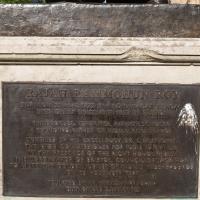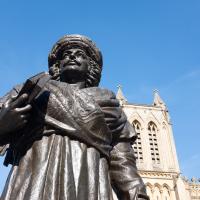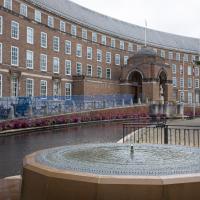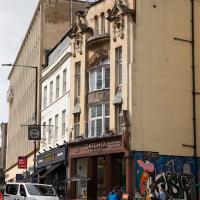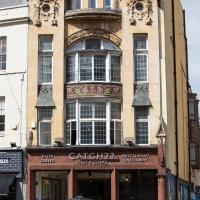Tagged: college-green
A Trip to the Library
08 Jun 2021
I had to return a book to the library—Ellic Howe's Magicians of the Golden Dawn, very interesting, thanks for asking—so I decided to pick the Central Library as my drop-off point and walk down a segment of Deanery Road that I've surprisingly overlooked so far. In any normal time I'd have been walking to work that way quite often, or heading through at the weekend on the way to do some shopping in the city centre, or for a coffee at St Nick's, but those excursions have been quite thin on the ground for the last year or so, for obvious reasons.
I've never been inside a single building on Deanery Road itself; the Library is technically on College Green and the rest is mostly student accommodation or Bristol College buildings, by the looks of things. It's a fairly mediocre street, used merely to get to other places. (St George's Road, which merges into it, at least has the distinction of several good shops verging from the practical and long-lived car radio fitters to the excellent little Dreadnought Books, sadly currently closed for refurbishment...)
After dropping off my book I came home via the harbourside, the better to enjoy the nice sunny blue skies of the day.
"He was known for his efforts to abolish the practices of sati and child marriage." I was aware of the awful practice of sati purely because it came up in a crossword once. Efforts to abolish it certainly seem statue-worthy.
This statue stands outside the Central Library, between it and City Hall. The Bristol connection is that he travelled to the UK as an ambassador "to ensure that Lord William Bentinck's Bengal Sati Regulation, 1829 banning the practice of Sati was not overturned". He died in Stapleton, Bristol in 1833. As well as this statue, he's buried in a fine mausoleum in the beautiful Arnos Vale cemetery.
It's still a popular moustache style among Indian gentlemen, if erstwhile workmates from Mumbai and other places are anything to go by.
The arch on the left is the Great Gatehouse of St Augustine's Abbey, precursor to the Cathedral; you can see the Library entrance just behind the Ram Mohan Roy statue.
Library, Bookshop, Coffee
03 Jul 2021
I was headed into town to return RA Gilbert's biography of AE Waite to the library and along the way I noticed that Dreadnought had finished their refurbishment, but wouldn't be open until midday. That left me some time to kill, so I bimbled around the old St Augustine's/Gaunt's area for a while, then headed up Park Street for a coffee and a snack to eat on Brandon Hill before heading home the way I'd came so I could pop in and buy a pamphlet on the Hot Well I'd been interested in for a while.
A protest was starting to form on College Green on my way past. As well as this one, there was also a Kill the Bill march that closed the M32 followed by "delirious" England fans having a mass celebration in the city centre, so I'm glad I wandered home pretty early. I wouldn't fancy being the Bristol Waste cleaning team as I write this, on Sunday morning...
When a samba band turns up, I leave. Several of my friends have greatly enjoyed performing in samba bands, and I find virtually everything about them makes me want to run in the opposite direction.
Something tells me that this side passage that leads through to the side door of the chapel has been here quite some time.
A Long Wander Of Miscellany and Magick
08 Aug 2021
This was a wide-ranging wander. I started off crossing the river to Bedminster, to walk a single little cul-de-sac, Hardy Avenue, that I'd managed to miss on at least one previous walk. Then, pausing only to explore a few back alleyways, I headed for a few destinations related mostly by the Hughes family, who I've been researching a little as part of background for a possible novel, as several of them were involved in the Stella Matutina.
However, mostly it's the artistic side of the family I wanted to explore today, as that's where most of their public history lies (as you might expect, there's often not much in the public record about the workings of an occult organisation.) First I visited College Green, where the façade of the Catch 22 Fish & Chip shop still bears the work of Catherine Edith Hughes. Then I wandered up to the top of Park Street to pop into the Clifton Arts Club's annual exhibition, as Catherine, her half-brother Donald, his wife Hope and at least two other Hugheses were members. Donald was chairman for 40 solid years; Hope was Secretary for eight, and Ellard and Margaret Hughes, two more Hughes siblings, were members along with Catherine.
Finally I walked home with a small diversion to Berkeley Square, to confirm the location of Donald Hughes's house by checking for a particular plaque by the front door.
I must admit I'm not entirely sure where all this research is really leading me, but I'm finding it quite interesting to bump across the faint lines of history that link the Hermetic Order of the Golden Dawn, founded in 1888, to modern, quotidian Bristol.
These days it's a fish and chip shop, but it started as the Cabot Cafe.
According to this description of an etching by Alexander Heaney:
Built in 1904 for an estate agent, Walter Hughes, to the design of Latrobe & Weston, architects well known for their cinemas. Above the word ‘Café’ can just be seen the Pomegranate mosaic with enamel insets by the client's daughter, Catherine Hughes, taken from Charles Rickett's bookbinding for Oscar Wilde's A House of Pomegranates, 1891.
Caroline's Miscellany tells us:
Less bright, but equally beautiful, are the copper panels to either side. These continue the pomegranate theme and are pure Art Nouveau. Other details, by contrast, are more baroque (a mixture of styles characteristic of LaTrobe and Weston's work).
Cabot Cafe suffered damage in the Second World War. We are fortunate, then, that this intriguing facade nevertheless survived to delight us today.
As I mentioned, these pomegranates were made by Catherine Hughes, daughter of the estate agent who commissioned the cafe.
The Hughes name is one to conjure with. I'm specifically interested in the Hughes family as I've been researching the Golden Dawn1 for a novel, and at least three Hugheses were members of its later offshoot, the Stella Matutina. Catherine Hughes (Lux Orta Est), who made these tiled pomegranates was, I believe, the first Imperatrix of the No. 28 Bristol Hermes Temple of the Stella Matutina, running it to begin with from her home at St Vincent's Studio, Redland, just off the top of Whiteladies Road.
We'll be hearing a bit more about some other members of the Hughes family in a little bit, as I decided to turn this wander into a bit of a magical excursion, for fun and research and because of handy timing and geographical coincidence.
I don't know if these pomegranates from 1904 predate Catherine Hughes's interest in magic per se, but they were made years before she joined the Stella Matutina, in early 1908, so I can't say that they were created by a practising magician!
1 No, not the Greek nutters. The British Victorian, er, eccentrics.
The side window canopies are copper, as you can probably tell by the green streaks below them.
Must've taken some time to put together. And done with some skill, to still look so good nearly 120 years later.

